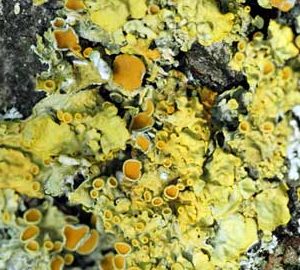Sunscreen for lichens, and a new film by Woodlands TV.

This is a re-post of a blog from 2023, but this time with the new film by WoodlandsTV, in which April Windle [of the British Lichen Society] examines the role of the many complex chemicals found in Lichens.
Lichens are plant-like organisms that are rather unusual in that they are an amalgam of two (or occasionally three) organisms : a fungus and algae (or cyanobacterium). They are symbiotic systems, where the partners in the association work together for mutual benefit. The fungus makes up the bulk of the lichen's form (known as the thallus), it is a complex network of fungal threads (hyphae) that surround the algal cells. The algae (green algae or cyanobacteria) are essential to the symbiosis as they can photosynthesise, capturing carbon dioxide and providing both partners with organic carbon compounds (often in the form of sugar alcohols).
Lichens produce an amazing variety of chemicals - many are secondary metabolites. It is thought that some of these may have medical / pharmacological properties. Some species of lichen are brightly coloured because of the chemicals.. The colour may vary from a golden yellow to a deep red. The pigments responsible for these colours belong to the anthraquinones. However, these insoluble, phenolic pigments can have toxic effects. To avoid harm by these pigments, the lichen exports* the pigment from the fungal component of the symbiosis.

Moss and lichen growing together
The pigment then accumulates / crystallises on the surface of the lichen. The layer of pigment crystals reflects harmful radiation in the form of ultra-violet light and also blue light, whilst still allowing enough light to pass through for photosynthesis by the algae / cyanobacteria. Exposure to ultra-violet light can damage DNA, inducing mutations. The pigmentl layer is effectively a ‘sunscreen’ for the lichen.
* Recent work at Imperial College and RBG, Kew has identified the genes responsible for pigment production, and the transport of the pigment out of the fungal tissue.
In the past, certain lichen pigments were often used to dye clothing materials. Parmelia saxatilis, also known as grey crottle, was used to dye wool for Harris Tweed. This lichen is often found growing on tree trunks and gives a red / brown colour to the material.
For more information on the various chemicals found in Lichens, see the WoodlandsTV film below : The Chemical, Medicinal and Biofluorescent Properties of Lichen.
Curious fact : Some specimens of the lichen Rhizocarpon geographicum are thought to have lived for thousands of years.
Comments are closed for this post.
